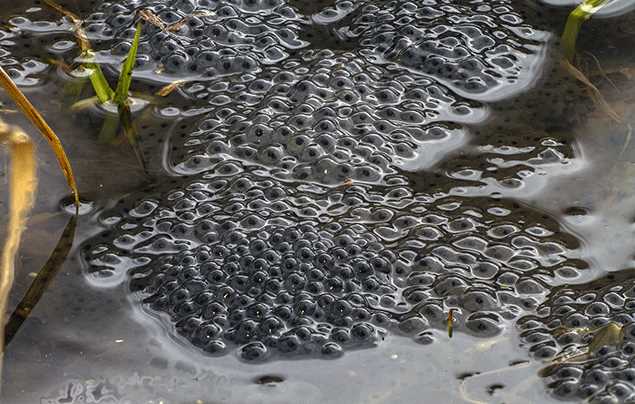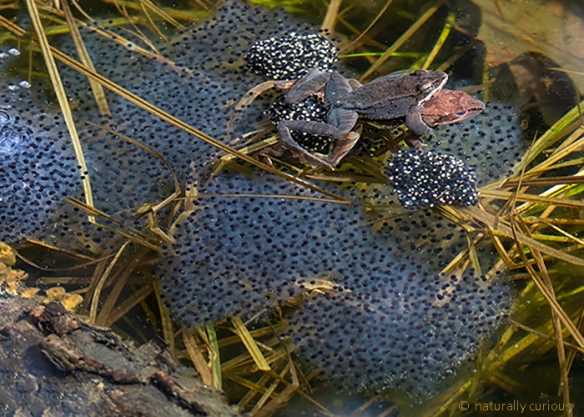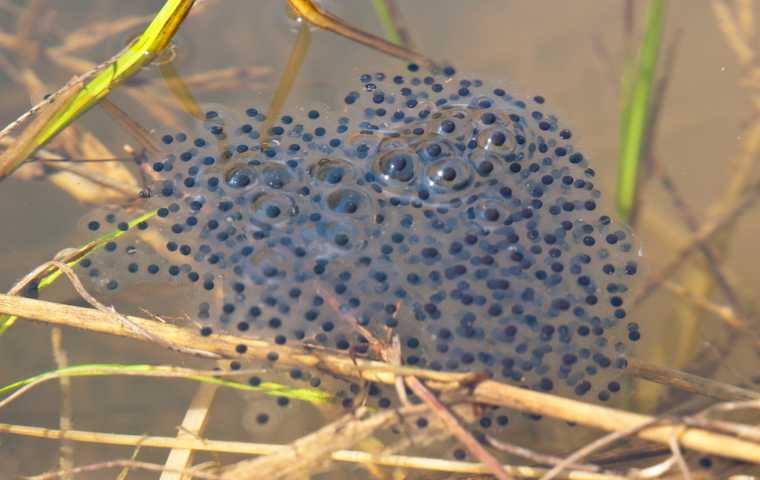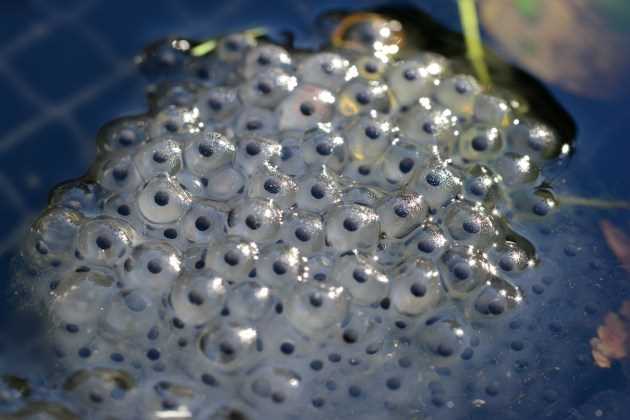What do frog eggs look like?
Look and feel of frog eggs
Frog eggs are typically round or oval in shape, with a gel-like texture. They are often translucent, allowing you to see the tiny tadpole developing inside. The size of the eggs can vary greatly, ranging from a few millimeters to several centimeters in diameter. Some frog species lay their eggs in clusters, while others lay them in string-like structures.
Color variations
The color of frog eggs can also vary depending on the species. Most commonly, frog eggs are clear or pale white. However, some species lay eggs that are dark brown, green, or even black. The coloration of the eggs can serve as a camouflage, helping them blend in with their surroundings and protect them from predators.
Identifying frogspawn can be a fun and educational activity. If you come across a gel-like mass of eggs in or near the water, you might have stumbled upon frogspawn. Pay attention to the shape, size, and color of the eggs to help you narrow down the species.
Remember, not all eggs found in or near water belong to frogs. Other amphibians, such as toads and salamanders, also lay their eggs in similar structures. If you’re unsure, consult a field guide or seek the advice of a local nature expert to help you identify the eggs correctly.
Importance of Identifying Frogspawn

Additionally, identifying frogspawn allows for the protection and conservation of these delicate life stages. Frog eggs are vulnerable to environmental changes and human activities such as pollution and habitat destruction. By knowing where and when frogspawn occurs, conservationists can implement measures to safeguard breeding sites and promote the survival of frog populations.
Physical Characteristics of Frog Eggs
Frog eggs are small, jelly-like spheres that vary in size depending on the species. They are typically translucent, allowing you to see the developing embryo inside. The eggs are usually laid in clusters, which resemble clumps of small pearls or grapes. These clusters are attached to plants, rocks, or other objects in the water.
The coloration of frog eggs can vary depending on the species. They can be translucent, clear, or have a pale green hue. Some species even have eggs with a yellow or brown tint.
Coloration and Texture of Frog Eggs

Frog eggs come in a variety of colors and have different textures depending on the species. The coloration of frog eggs can range from clear or translucent to white, brown, or even black. Some species of frogs have eggs that are brightly colored, while others have more subdued tones.
The texture of frog eggs can also vary. Some eggs are smooth and gelatinous, while others have a more bumpy or grainy texture. The outer layer of the eggs protects them from drying out and predators. This outer layer can be slimy or sticky, allowing the eggs to adhere to underwater plants or rocks.
What do frog eggs look like?
The color of frog eggs can vary depending on the species. Some species have translucent eggs while others have eggs that are black or brown. The texture of the eggs is smooth and slimy, allowing them to adhere to surfaces such as vegetation or rocks.
Frog eggs are also unique in their shape. Most species lay their eggs in a circular or oval shape, similar to a small jelly droplet. The size of the eggs can range from a few millimeters to a few centimeters in diameter, depending on the species.
Threats to frog eggs include habitat loss, pollution, and climate change. Human activities, such as urban development and agriculture, can destroy or alter the habitats where frogs lay their eggs. Pollution from chemicals and pesticides can also be harmful to the development of frog embryos. Climate change can affect the temperature and water quality of frog habitats, which can impact the survival and development of the eggs.
Conservation efforts are essential to protect frog eggs and ensure the survival of frog populations. Measures such as habitat restoration, pollution control, and education about the importance of frogs and their eggs can help preserve these vital components of ecosystems.
Where to Find Frog Eggs
Frog eggs can be found in a variety of habitats, including ponds, lakes, streams, and wetlands. These locations provide the necessary conditions for the eggs to develop and hatch into tadpoles.
The female frog will then lay her eggs in clusters, which are often attached to some form of structure, such as vegetation or rocks. These clusters, called frogspawn, can contain hundreds or even thousands of eggs.
Therefore, when observing or studying frog eggs, it is crucial to do so without directly handling or moving them. By respecting the natural environment and allowing the eggs to develop undisturbed, we can ensure the continued survival and growth of these fascinating amphibians.
Differentiating Frog Eggs from Other Amphibians
Physical Characteristics
Frog eggs are typically jelly-like in texture and appear as gelatinous masses or clusters. They can be translucent, allowing you to see the embryos developing inside. The eggs are usually round or oval-shaped, and their size can vary depending on the species. Some frog eggs can be as small as a few millimeters, while others can reach a centimeter or more in diameter.
Coloration and Texture
The coloration and texture of frog eggs can also provide clues for identification. While most frog eggs are clear or pale in color, some species have pigmented eggs that can range from white to yellow, gray, or even black. The texture can vary as well, with some eggs having a smooth surface and others having a slightly bumpy or grainy texture.
Location

Another way to differentiate frog eggs from other amphibians is by their location. Frog eggs are usually found in freshwater environments, such as ponds, lakes, swamps, or slow-moving streams. They are often attached to vegetation or submerged objects, like rocks or logs.
Egg-Laying Behavior
The egg-laying behavior of frogs can also help in identification. Female frogs usually lay their eggs in large batches, often laying hundreds or even thousands of eggs at once. The eggs are usually deposited on or near the water’s surface, where they will develop and hatch into tadpoles.
| Frog Eggs | Other Amphibian Eggs |
|---|---|
| Usually round or oval-shaped | Can have various shapes |
| Jelly-like texture | Texture varies |
| Translucent | May or may not be translucent |
| Often attached to vegetation or submerged objects | Location varies |
| Large batches of eggs | Small or large batches of eggs |
By considering these physical characteristics, coloration, location, and egg-laying behavior, you can successfully differentiate frog eggs from those of other amphibians. This knowledge is essential for researchers, conservationists, and anyone interested in studying or protecting these fascinating creatures and their delicate life cycles.
The Development of Frog Eggs

So, what do frog eggs look like? Frog eggs are usually transparent or translucent, allowing observers to see the tiny embryos developing within. The eggs are composed of multiple cells and can vary in size depending on the species of frog. Some may be as small as a few millimeters, while others can reach several centimeters in diameter.
The development of frog eggs occurs in stages. After the eggs are laid, they begin to absorb water, causing them to swell. Within a few days, the embryos develop and take on the shape of a tadpole. The embryos continue to grow, developing eyes, gills, and a tail. Eventually, the embryonic stage concludes, and the tadpoles hatch from the eggs.
Throughout the development process, the eggs require a suitable environment to thrive. Adequate oxygen and water quality are crucial for the successful development of the embryos. Any disruptions or pollutants in the water can negatively impact the eggs and hinder their development.
The Role of Frogspawn in the Ecosystem
Frogspawn, which refers to the cluster of frog eggs, plays a crucial role in the ecosystem. These eggs are not only fascinating to observe, but they also contribute significantly to the balance of the ecosystem.
Importance of Frogspawn
Role in Nutrient Cycling
Habitat Engineering
Indicators of Ecosystem Health
The presence and abundance of frogspawn can serve as an indicator of the health of aquatic ecosystems. Frog eggs require clean water with suitable oxygen levels to survive and develop. Therefore, the presence of healthy and thriving frogspawn indicates the quality and viability of the surrounding ecosystem. Monitoring and conserving frogspawn populations can help professionals assess and protect the overall health of aquatic habitats.
| Summary: |
|---|
Predators: Like any other organism, frog eggs are vulnerable to predation. Many animals, including fish, birds, snakes, and insects, see frog eggs as a tasty meal. These predators can significantly impact the survival rate of frog eggs, especially in areas where their numbers are high.
Habitat Destruction: The destruction of natural habitats due to urbanization, deforestation, and pollution has a severe impact on frog eggs. Changes in water quality, temperature, and oxygen levels can harm or even kill the developing embryos, affecting the overall population of frogs in the ecosystem.
Invasive Species: Invasive species, such as non-native fish and bullfrogs, can pose a significant threat to frog eggs. These invasives often outcompete native species for resources, including food and nesting sites. They may also consume or destroy frog eggs, further contributing to their decline.
Climate Change: The warming climate and altered weather patterns have a direct impact on the development and survival of frog eggs. Changes in rainfall patterns, increased droughts, and rising temperatures can disrupt the breeding cycles and reduce the availability of suitable habitats for laying eggs.
Pollution: Pollution, including chemicals from agricultural runoff, industrial waste, and pesticides, can contaminate water bodies where frogs lay their eggs. The presence of these pollutants can impair the growth and development of frog eggs, leading to deformities or death.
Disease: Various diseases, including chytridiomycosis, can affect frogs and their eggs. These infectious diseases are caused by fungi and can spread rapidly, resulting in high mortality rates among frog populations.
Overharvesting: In some regions, frog eggs are collected for culinary purposes or the pet trade. Overharvesting can have detrimental effects on frog populations, disrupting their natural reproductive cycle and reducing their numbers.
Conservation Efforts for Frogspawn
However, frog populations around the world are facing numerous threats, including habitat loss, pollution, climate change, and the introduction of non-native species. These threats have resulted in a decline in frog populations and a significant impact on the global biodiversity.
To conserve frogspawn and protect the diverse range of frog species, various conservation efforts are being implemented:
- Habitat Protection: Preserving and restoring the natural habitats of frogs is essential for their survival. This includes protecting wetlands, ponds, and other freshwater sources where frogs lay their eggs.
- Reducing Pollution: Implementing measures to reduce water pollution, such as controlling the use of pesticides and fertilizers, can help maintain a healthy environment for frogspawn. Additionally, raising awareness about the harmful effects of pollution on amphibians is crucial.
- Climate Change Mitigation: Addressing the impacts of climate change, such as rising temperatures and changing precipitation patterns, is vital for the long-term survival of frogspawn. This may involve promoting renewable energy sources, reducing greenhouse gas emissions, and conserving water resources.
- Education and Outreach: Educating the public about the importance of frogspawn and the threats they face can inspire individuals to take action. This includes raising awareness about the significance of frogs in the ecosystem and facilitating citizen science programs to monitor frog populations.
- Invasive Species Management: Controlling the spread of non-native species that can negatively affect frog populations is crucial. This may involve implementing measures to prevent the introduction of invasive species and managing existing populations through appropriate methods.
By implementing these conservation efforts, we can protect and restore frogspawn populations, ensuring the survival of these fascinating amphibians and maintaining the ecological balance of our planet.

I’m Lena Adams—a product of an unconventional upbringing in the African wilderness. My father, a daring explorer of African wildlife, sparked my fascination with reptiles, a passion that intertwined with the tragic loss of my mother during an expedition, leaving an indelible mark on my life. Driven to understand the creatures that captivated my parents, I embarked on my journey, sharing insights about reptiles, frogs, and lizards on my website. Through my explorations and conservation efforts, I honour my family’s legacy while seeking connections—to the creatures, nature, and the mother whose presence I yearn to understand.
